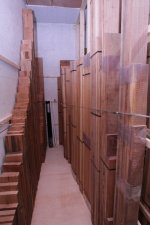lshah72414
Member
- Joined
- Nov 10, 2016
- Messages
- 143
The topic about hitting the mother load got me to thinking.
As the title suggests, should I buy wood for only my immediate needs? or buy a lot when I can find it cheap?
I have an unheated garage to store it in, so snow or rain won't get it, but , I live in Michigan and its extremely cold now, and it gets very hot and humid mid summer. What does every body else do?
I have a moisture gauge and the oak which I bought kiln dried about 18 months ago, which at the time had a moisture content of 6-8% , now reads 13 or 14%. Do you have to redry the wood before you use it?
Thanks for your help
As the title suggests, should I buy wood for only my immediate needs? or buy a lot when I can find it cheap?
I have an unheated garage to store it in, so snow or rain won't get it, but , I live in Michigan and its extremely cold now, and it gets very hot and humid mid summer. What does every body else do?
I have a moisture gauge and the oak which I bought kiln dried about 18 months ago, which at the time had a moisture content of 6-8% , now reads 13 or 14%. Do you have to redry the wood before you use it?
Thanks for your help

